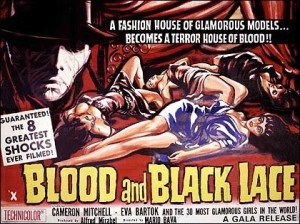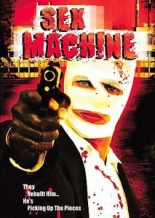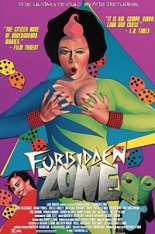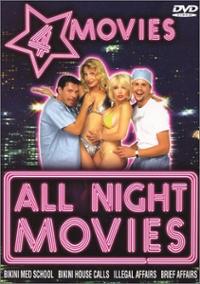Can you guess what movie or TV show we’re watching? We’ve turned on subtitles (when available) not to give you a clue, but to enhance that WTF effect! Leave your best guess in the comments to prove your true Flick Attackosity!


 At first glance, Mike Mayo’s The Horror Show Guide: The Ultimate Frightfest of Movies looks like one of those beloved, phone-directory-thick Videohound genre guides Visible Ink Press issued throughout the ’90s, particularly his own Videohound’s Horror Show.
At first glance, Mike Mayo’s The Horror Show Guide: The Ultimate Frightfest of Movies looks like one of those beloved, phone-directory-thick Videohound genre guides Visible Ink Press issued throughout the ’90s, particularly his own Videohound’s Horror Show.
Turns out there’s a good reason: The new book is a second edition of that 1998 book, but stripped of the Videohound brand. Thus, gone is the dog-bone rating system, along with many capsule reviews of the earlier work.
Although Horror Show Guide claims to review more than 1,000 movies (compared to the first edition’s 666), it doesn’t feel like it. For a number of reasons, it seems less authoritative — and not just because Mayo calls The Mothman Prophecies “one of the very best” of scare cinema.
In addressing one 1960 picture that rightly is considered a bona fide classic, the author praises it like he should … but only under its alternate title of The Horror Chamber of Dr. Faustus without mentioning the one that curious consumers would need to search in order to purchase it: Eyes Without a Face. Otherwise, it’s of little help or value to readers.
While Mayo does take advantage of an updated edition by including many titles that came into being within the last 15 years (likes Misty Mundae and Amber Heard’s tits; dislikes 3D and Rob Zombie), a number of them are simply not horror: Mel Gibson’s Jesus epic, The Passion of the Christ; the Italian sex-comedy omnibus Boccaccio ’70; Steven Soderbergh’s all-star medical thriller, Contagion; the Nicolas Cage action vehicle Drive Angry; the weather-paranoiac drama Take Shelter; and — why, God, why? — those wretched Twilight teenage romances. I wouldn’t worry about their inclusion so much if he hadn’t had to cut out so many legitimate films to make room for them.
Many of the photos are irrelevant (like, red-carpet paparazzi shots) instead of being stills or posters, or inexcusably printed in low resolution. Mayo makes some glaring errors along the way (such as crediting William Friedkin as director of 1996’s The Island of Dr. Moreau debacle) and has a real problem with properly reporting titles.
Or should I say the problem with properly reporting titles? In many instances, he adds the word “the” where there shouldn’t be; in many more, he leaves the word off when it should be there. This infects the book throughout, which makes him look lacking in knowledge and/or his editor look lazy.
If you own Videohound’s Horror Show, stick with that. This not-ultimate Ultimate Frightfest update comes up far too short to be worth an upgrade. —Rod Lott

 A fine line exists between European arthouse films and European horror films, argues Ian Olney, and he makes a convincing case for it in Euro Horror, a paperback study for Indiana University Press.
A fine line exists between European arthouse films and European horror films, argues Ian Olney, and he makes a convincing case for it in Euro Horror, a paperback study for Indiana University Press.
Of course, many closed-minded people think no line exists between horror and pornography, so Olney also spends a great deal of time drawing one, while admitting similarities. In both instances, it has helped horror’s cause that lavish DVD editions have rescued the films from obscurity; such discs’ all-out-extras treatment have lifted the genre from the depths of the lowbrow to an artful respectability.
Throughout his book, the author forces the reader to think harder about these movies, to see that there’s more going on beyond mere exploitation. Yes, even in the seemingly tossed-off works of your Jess Franco and Joe D’Amato.
The bulk of Euro Horror divides itself into three “case studies”: the giallo, the “S&M horror film” and the ever-popular cannibals and zombies. Olney examines and deconstructs iconic films among these subgenres to address themes of racism, sexuality and otherwise. For example, with regard to women-in-prison pictures, “[they] not only privilege the lesbian gaze, but also invite viewers to adopt it themselves.”
Naturally, in studies such as these, how much of what the author proposes is shared by the filmmaker (at least consciously) is impossible to quantify; you either see merit in the argument or not.
 I see plenty of merit, but then again, I’m predisposed to loving these films. Here, among dozens upon dozens cited and considered, some getting considerably more play include Mario Bava’s Blood and Black Lace, Lucio Fulci’s Zombie, Emilio Miraglia’s The Red Queen Kills 7 Times, Franco’s Eugenie de Sade, Dario Argento’s The Bird with the Crystal Plumage, D’Amato’s Images in a Convent, Ruggero Deodato’s Cannibal Holocaust and, yep, even Claudio Fragasso’s Troll 2.
I see plenty of merit, but then again, I’m predisposed to loving these films. Here, among dozens upon dozens cited and considered, some getting considerably more play include Mario Bava’s Blood and Black Lace, Lucio Fulci’s Zombie, Emilio Miraglia’s The Red Queen Kills 7 Times, Franco’s Eugenie de Sade, Dario Argento’s The Bird with the Crystal Plumage, D’Amato’s Images in a Convent, Ruggero Deodato’s Cannibal Holocaust and, yep, even Claudio Fragasso’s Troll 2.
It is with the latter film that Olney gives too much credence to bloggers (especially one who apparently can’t write a sentence without the word “fucking”) to back up his points, but thankfully, that’s the only time. Everywhere else, he draws from a wealth of credible sources that place him in solid company. His only other misstep is minor: believing that making the “New Releases” wall at Blockbuster Video has something to do with popularity, and not for simply being a new release. (Sadly, I speak from personal, retail-hell experience.)
A film professor at English at York College of Pennsylvania, the author is a smart guy with a smart book — too smart for casual readers of criticism, fascinating for those of us who don’t mind academia intruding upon our 90 minutes of anarchy.
For a wider-scoped, less-scholarly book on the same subject, I highly recommend Danny Shipka’s Perverse Titillation of 2011. When you’re done with that and ready for a graduate course, enroll in Euro Horror — time and money well-spent. —Rod Lott

 To answer your first question: Fervid Filmmaking refers to those movies which author Mike Watt believes to contain everything but the kitchen sink, as if their creators threw in every element imaginable, just in case they never got another chance to direct again.
To answer your first question: Fervid Filmmaking refers to those movies which author Mike Watt believes to contain everything but the kitchen sink, as if their creators threw in every element imaginable, just in case they never got another chance to direct again.
In other words, cinema with “total chaos and total control.” As this paperback’s subtitle promises, he’s chosen exactly 66 of them to spotlight.
To answer your second question: No, he’s not that Mike Watt.
Although I’d be curious to see what cult pics the punk legend recommends, this Mike Watt has written for Film Threat, Fangoria, Femme Fatales and some publications that don’t begin with the letter F. Here, he covers movies I thought only I loved (O.C. and Stiggs), movies I thought only I had seen (Meet the Hollowheads), movies I thought only I had heard of (Sex Machine). That doesn’t mean every film featured is beloved by him (for example, the hippie sketch comedy Dynamite Chicken); it need only fit the criteria. Unsurprisingly, he pretty much loves the majority anyway.
 Directors represented include such Hollywood heavyweights as Robert Altman, Steven Soderbergh and George A. Romero, but not for the movies you readily associate with them. On the other side of the spectrum are outré names that include Doris Wishman, William Castle and Lloyd Kaufman (who provides the book’s amusing introduction). And then way, way off said spectrum are names you’ve likely never run across, mostly guys who toil in pixels vs. film.
Directors represented include such Hollywood heavyweights as Robert Altman, Steven Soderbergh and George A. Romero, but not for the movies you readily associate with them. On the other side of the spectrum are outré names that include Doris Wishman, William Castle and Lloyd Kaufman (who provides the book’s amusing introduction). And then way, way off said spectrum are names you’ve likely never run across, mostly guys who toil in pixels vs. film.
But what makes Fervid Filmmaking as throughly enjoyable as it is — only one reason, actually — is that Watt puts them all on a level playing field. Otto Preminger equals Alejandro Jodorowsky equals Alvin Ecarma. Whether their product played to millions of eyeballs in a worldwide theatrical release or has screened to maybe just Watt and his friends via bootleg VHS, no one is placed on an automatic pedestal because of a larger budget. In his view, they’re all filmmakers who took some really ballsy, often unpopular chances, so everyone deserves a salute.
 And each essay, arranged alphabetically and sporadically illustrated, is well thought-out, vastly entertaining and even educational. With this book, Watt reveals himself as a legitimate, excellent film critic; this is serious stuff, even if the stuff he discusses deals with a cavewoman clubbing Hitler (Forbidden Zone), a hatred of grapes (Psychos in Love) or David Carradine in drag (Sonny Boy).
And each essay, arranged alphabetically and sporadically illustrated, is well thought-out, vastly entertaining and even educational. With this book, Watt reveals himself as a legitimate, excellent film critic; this is serious stuff, even if the stuff he discusses deals with a cavewoman clubbing Hitler (Forbidden Zone), a hatred of grapes (Psychos in Love) or David Carradine in drag (Sonny Boy).
In-depth without overstaying their welcome, the pieces are all tight, too. The only exception would be Repo! The Genetic Opera, which introduces a cast it then re-introduces a couple pages later. (Outright errors are precious few, too, with the most glaring calling Susan Tyrell an Oscar winner; she didn’t get past the nomination.)
My only other complaint is that Watt’s work is heavy on footnotes. This is fine when he’s imparting supplementary information, but needless when he’s sharing a cast member or creative’s credit, partly because they’re often shared within the main body. For the obsessive like me, they derail the flow of reading, and even more so when the numbers don’t match up, which occurs on several occasions.
No worries, kids; it’s all good. Twenty-five years ago, Fervid Filmmaking would have enjoyed a wide release by one of the major publishing companies, and you would have read a chapter or two at your mall’s Waldenbooks or B. Dalton before realizing this was one that would be worth buying and keeping. In today’s wired world, it has a home with McFarland & Company — a fine publisher, but harder for people to find and priced higher. My hope is that, like the movies Watt shines a light on, the right people will find it, and realize its worth. —Rod Lott

 1. Bikini Med School and Bikini House Calls look like they’re cobbled together from some really awful Skinemax series.
1. Bikini Med School and Bikini House Calls look like they’re cobbled together from some really awful Skinemax series.
2. In both, various sexual couplings occur in a frat-house room among a stock group of med students.
3. Downstairs, horse-faced strippers who don’t strip dance to excruciating butt-rock tunes.
4. Occasionally, the movies cut to old stock footage of medical whatnot, sometimes in the middle of a line, for no discernible reason.
5. They also share the same group of unappealing characters.
6. In 1994’s Bikini Med School, two guys bet each other $100 that they can trick a girl into sex.
7. This being a film with “bikini” in the title, they succeed.
8. Writer/director (to use those terms lightly) Michael Paul Girard loved this plot so much that he repeated it in the second half.
9. 1996’s Bikini House Calls is more of the same, except with a fantasy sequence, more panty-sniffing, a fake orgasm contest and a prank pulled with itching powder.
10. Girard is also to blame for 1993’s Illegal Affairs (aka Divorce Law) and A Brief Affair.
11. Those films offer the same sophomoric episodic romps where the comedy is as simulated as the sex, but set in a law firm so that, as one friend put it, the characters can “go to court and fuck on desks.”
12. B-movie regulars Jay Richardson and Monique Parent star, perhaps regrettably, in both.
13. I like to refer to the guy on the right of the DVD cover as Vo-Tech Mullet Party Dude. —Rod Lott